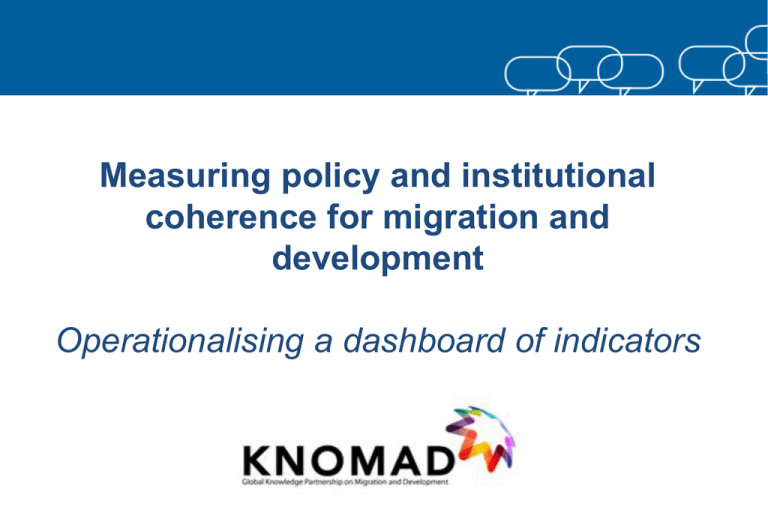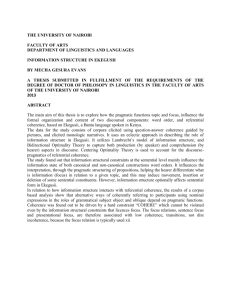General Presentation on Dashboard of PICMD Indicators
advertisement

Measuring policy and institutional coherence for migration and development Operationalising a dashboard of indicators A KNOMAD initiative Thematic Working Group 5 Policy and Institutional Coherence Why does policy coherence matter? Policy and institutional coherence for migration and development (PICMD) can: Help reduce the negative effects of incoherence, e.g., spill over effects, financial costs and large-scale inefficiencies Assist in balancing policy trade-offs and enhance collaboration, trust and synergies among stakeholders Help clarify the interrelations between policies, migration and development Measuring coherence 3 main challenges Who defines the objectives? Defining objectives Is coherence measurable? Can we compare countries? What are the priorities? How to limit conflicting objectives? Monitoring policy coherence Assessing impacts What are the benefits/costs of coherence/incoherence? How to identify causal chains? The dashboard of indicators Objectives The dashboard of indicators for measuring policy and institutional coherence for migration and development (PICMD) aims to: Take stock of their existing policies and institutional arrangements in different sectors related to migration and development; Consider what policies and institutions may be needed to maximise the positive impact of migration and development. Levels of measurement Inputs, outputs and outcomes The dashboard of indicators aims to measure policy and institutional coherence at three different levels: inputs, outputs and outcomes, defined as: INPUTS: processes that lead to government interventions, such as consultations, statements of commitment and the allocation of financial resources. OUTPUTS: government interventions, in particular policy and institutional changes. These include the adjustment and establishment of policies, as well as the set-up and modification of formal mechanisms such as inter-ministerial committees and centralised oversight bodies. OUTCOMES: short and medium-term effects on society of government outputs. They differ from impacts, which refer to the intended and unintended long-term effects of interventions. A dashboard of indicators Monitoring policy coherence Inputs Consultations with stakeholders Public commitment to harnessing the positive links between migration and development Sending/ receiving countries Sending/ receiving Receiving Sending Budget size and allocation Outputs Outcomes Formal mechanisms for interministerial co-ordination Increased number of policy decisions aimed at maximising the positive impact of migration on development Health services for migrants Increased access of all migrants to health care Systems for recognition of foreign degrees and skills Increased labour market opportunities for migrants; reduction of brain waste Remittances comparison website Lower remittance costs Regulation framework for recruitment agencies Lower costs of migrating Investment incentives offered to diaspora members Increased diaspora investment in countries of origin Dashboard operationalisation Practical details Participating countries: Bosnia and Herzegovina, Cape Verde, Jamaica, Moldova, the Netherlands, the Philippines, Sri Lanka, Sweden, Switzerland, and Trinidad and Tobago The Thematic Working Group’s research team works closely with a national focal point in each participating country. An international expert meeting was held in June 2015 to bring experts and policy makers together to discuss the strength of the indicators. Two national workshops (June-July), in the Netherlands and Cape Verde, will serve as opportunities to discuss challenges related to operationalising the dashboard at the country level. The final results of the initiative will be presented at the 8th Global Forum on Migration and Development in Istanbul in October 2015. THANK YOU






